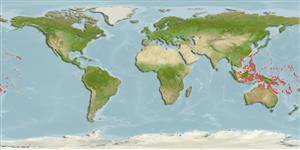>
Eupercaria/misc (Various families in series Eupercaria) >
Scaridae (Parrotfishes) > Scarinae
Etymology: Chlorurus: Greek, chloros = green + Greek oura = tail (Ref. 45335).
More on author: Bloch.
Environment: milieu / climate zone / depth range / distribution range
Ökologie
seewasser riff-verbunden; tiefenbereich 0 - 20 m (Ref. 9710). Tropical; 30°N - 24°S, 102°E - 153°W
Pacific Ocean: Ryukyu Islands to Australia. Recently reported from Tonga (Ref. 53797).
Size / Gewicht / Alter
Maturity: Lm ? range ? - ? cm
Max length : 56.2 cm FL Männchen/unbestimmt; (Ref. 125599); max. veröff. Gewicht: 2.2 kg (Ref. 125599)
Rückenflossenstacheln (insgesamt): 9; Rückenflossenweichstrahlen (insgesamt): 10; Afterflossenstacheln 3; Afterflossenweichstrahlen: 9. This species is further distinguished by having the following characters: median predorsal scales 4; scale rows on cheek 2; conical teeth absent on side of lower dental plate, 0-2 on upper plate of initial phase and often 2 on terminal male; lips slightly covers the dental plates; caudal fin in subadult slightly rounded to truncate and slightly emarginate in terminal male. Colour of male distinctly bicolored, with purple-brown anterior, and oblique division to pale yellow posterior; female entirely dark brown with red-orange tail (Ref. 9793, 90102).
Inhabits seaward coral (Ref. 58652) and rocky reefs (Ref. 9710); inner reefs with rich coral habitat (Ref. 48636). Feeds on benthic algae (Ref. 3488). May occur in small groups of 1 TP with 1 to 3 IPs (Ref. 9793). Caught mainly with traps, nets and other types of artisanal gear. Minimum depth reported taken from Ref. 128797.
Life cycle and mating behavior
Geschlechtsreife | Fortpflanzung | Ablaichen | Eier | Fecundity | Larven
Oviparous, distinct pairing during breeding (Ref. 205).
Randall, J.E. and J.H. Choat, 1980. Two new parrotfishes of the genus Scarus from the Central and South Pacific, with further examples of sexual dichromatism. Zool. J. Linn. Soc. 70:383-419. (Ref. 2689)
IUCN Rote Liste Status (Ref. 130435)
Bedrohung für Menschen
Harmless
Nutzung durch Menschen
Fischereien: kommerziell; Aquarium: Kommerziell
Mehr Information
ReferenzenAquakulturAquakultur ProfilZuchtlinienGenetikElectrophoresesVererbbarkeitKrankheitenVerarbeitungNutrientsMass conversion
PartnerBilderStamps, Coins Misc.LauteCiguateraGeschwindigkeitSchwimmstilKiemenoberflächeOtolithsGehirngrößeSehfähigkeit
Tools
Zusatzinformationen
Download XML
Internet Quellen
Estimates based on models
Preferred temperature (Ref.
123201): 25 - 29.3, mean 28.5 °C (based on 2061 cells).
Phylogenetic diversity index (Ref.
82804): PD
50 = 0.5000 [Uniqueness, from 0.5 = low to 2.0 = high].
Bayesian length-weight: a=0.01259 (0.00710 - 0.02233), b=3.03 (2.88 - 3.18), in cm total length, based on LWR estimates for this species & (Sub)family-body (Ref.
93245).
Trophic level (Ref.
69278): 2.0 ±0.00 se; based on food items.
Widerstandsfähigkeit (Ref.
120179): mittel, Verdopplung der Population dauert 1,4 - 4,4 Jahre. (Preliminary K or Fecundity.).
Fishing Vulnerability (Ref.
59153): Moderate vulnerability (45 of 100).
Nutrients (Ref.
124155): Calcium = 42.6 [17.5, 144.3] mg/100g; Iron = 0.666 [0.266, 1.657] mg/100g; Protein = 18.6 [16.6, 20.4] %; Omega3 = 0.0929 [, ] g/100g; Selenium = 31.3 [10.9, 94.3] μg/100g; VitaminA = 51.9 [16.1, 170.8] μg/100g; Zinc = 2.37 [1.06, 4.28] mg/100g (wet weight);
